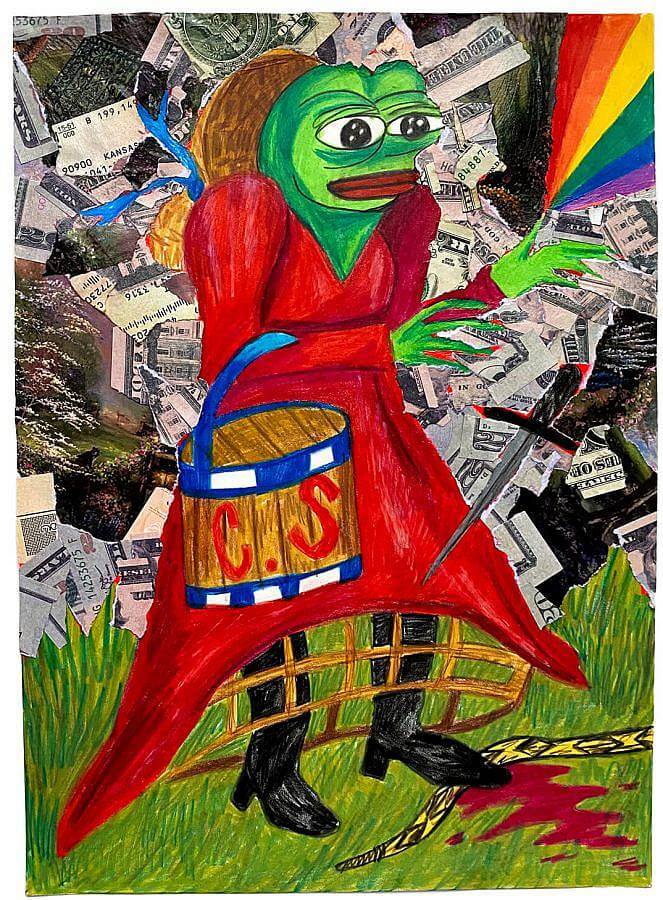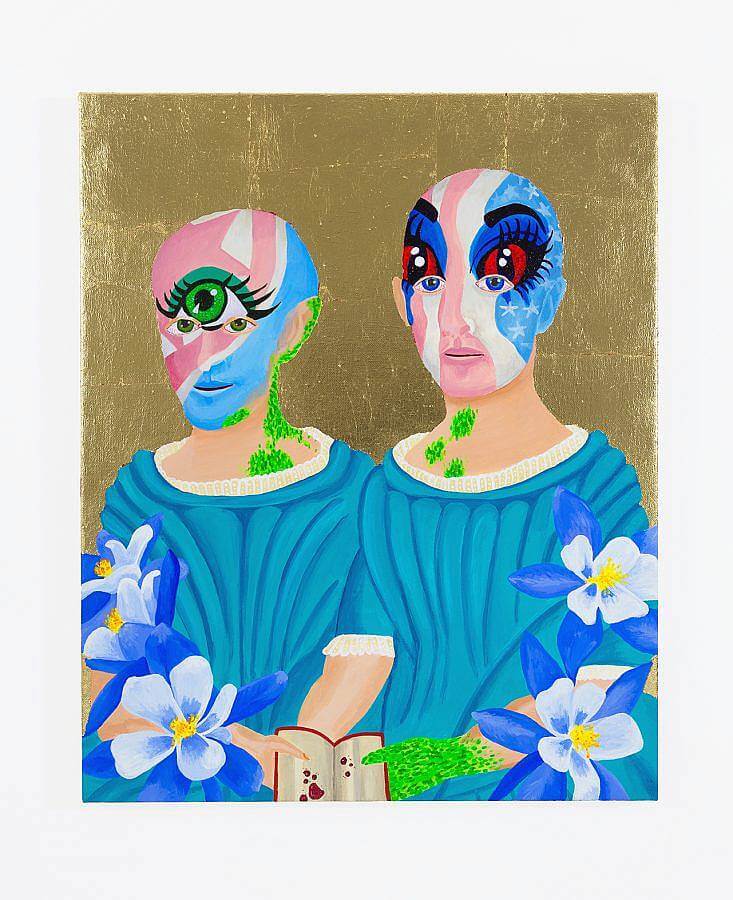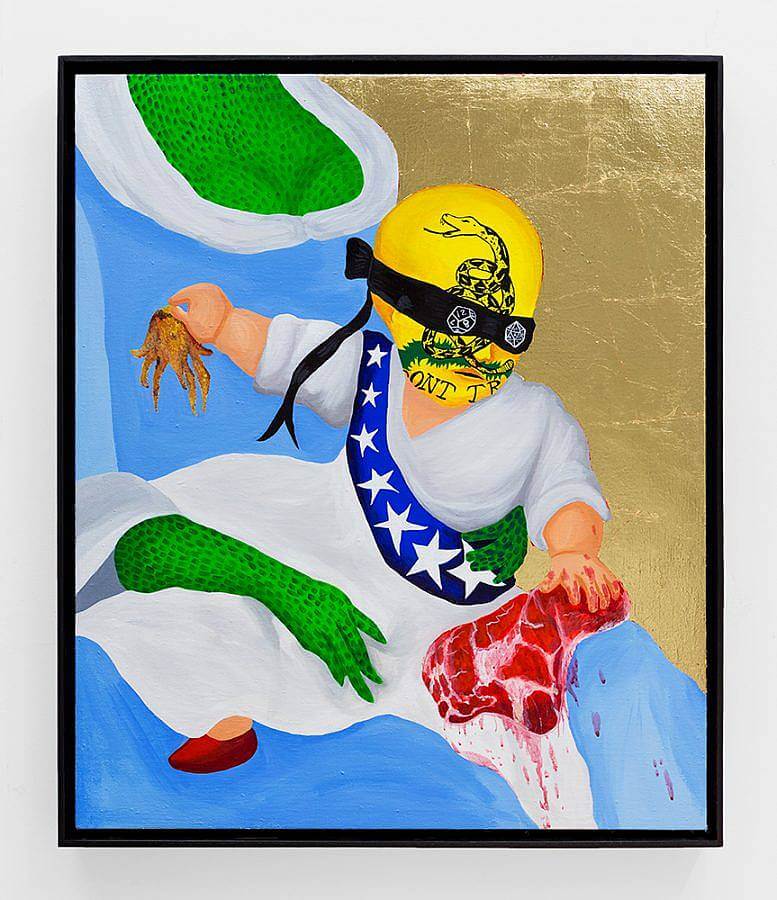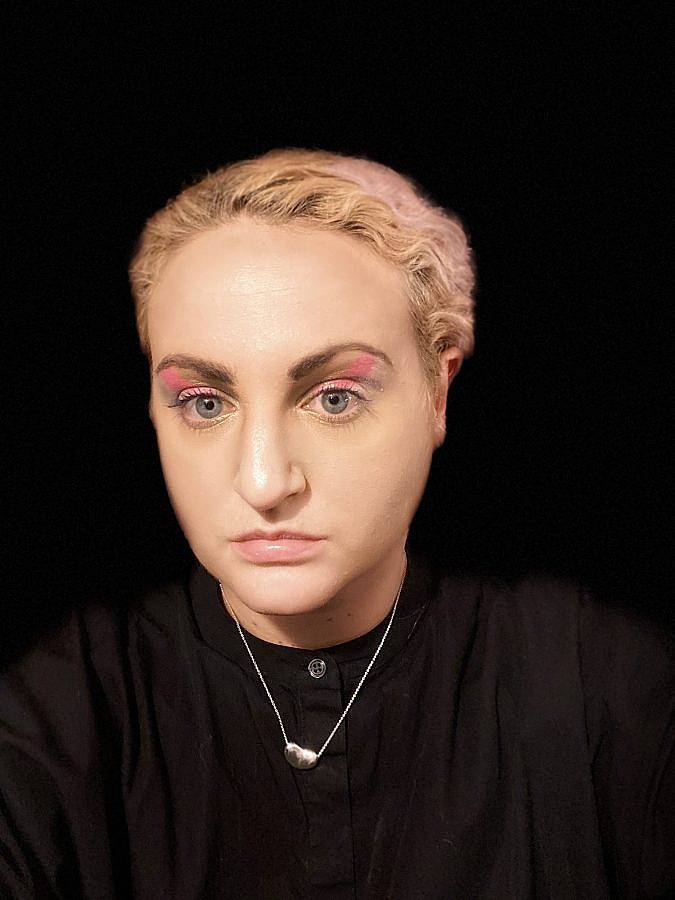Tell us a bit about yourself and what you do.
Since 2018, I have been studying the nature of identity, money, and power expressed in early American art, as revealed by itinerant portraits of children. The pictures that I use as a template were primarily painted in the 17th through 19th centuries by artists like John Brewster Jr. and Ammi Phillips. They represent genealogical trophies as most of the children painted did not live past childhood.
I am interested in focusing on these most vulnerable members of society through portraiture, much like an itinerant artist. Using drawing, painting, performance, and video, I re-interpret history using an “unhinged” Yankee alter-ego named Old Put, a shape-shifting alien clown.
Old Put is an alternative identity that I created in 2012 to channel the darkest conspiracy theories. When I began researching conspiracy theories, they were more a part of a fringe culture that has now become tragically mainstream.
Your alter ego’s story is documented through multiple plays, but for those who don’t know, can you introduce us to Old Put?
Old Put is my shape-shifting alien clown alter ego. When I don their personality, it works as a type of therapy for me to digest what is happening in my life and in American culture and politics. They are obsessed with making crafts and want to achieve greatness with their work.
Old Put also allows me to rethink what gender and identity can be. I was first inspired by Divine, Jack Smith, and RuPaul. I know drag can be more fluid than what is represented by my heroes.
Trigger Cancel the Warning Culture from BAILEY SCIESZKA on Vimeo.
How did you get started as an artist and performer?
Honestly, going to theater camp in middle school ruined me. But when I learned drawing was a profession, it was pretty much over for me. Even now, I use drawing to organize my ideas for painting and performance.
I started using the character of Old Put in videos I made during my last two years at Cooper Union. It wasn’t until I did a laboratory with The PuppetArt Theater in Detroit, that I started serializing this alter-ego in live performances and videos.
How does ‘Conspiracy,’ and the extravagant symbolism that comes with its theories, visually inform your practice?
Last Podcast on the Left sparked my interest in the history of fringe political beliefs. I am blown away by the amount of myth-making that goes into these conspiracy theories. My deep love and disgust for American history really led me to try and think about how this is our nation’s history too. In his 2017 book Fantasyland, Kurt Andersen perfected the ideas I want to rearticulate in art: this is a nation that is addicted to the tallest tales.
There is an extreme amount of lingo and symbolism in these radicalized communities. It reminds me of the details in early American paintings. In my art, I rework and add these conspiracy theory symbols as a way to shine a light on the complicated “Fantasyland” ethos of this country.

What was the inspiration behind your first drawing of 2021?
“Pepe in Petticoats #1” is a drawing I finished the morning of January 6th right before the insurrection at the Capitol.
I was inspired to make a drawing about the Confederate president, Jefferson Davis, being caught in his wife’s dress while attempting to escape Union soldiers. This story was so popular in the Reconstruction era that P.T. Barnum sold little carte de visites of this scene in his American Museum in New York City. I even found one of these cards on eBay.
Pepe the Frog is an alt-right meme idol. Writing this now, I can see that I was a little too on the money by comparing maga heads to the lost cause of the Confederacy. The racism and hatred behind maga and republicans is reminiscent of the south during the civil war, so I remade the Jefferson Davis print to star Pepe.

You recently posted about “Little Boy the Dolphin,” 2018, can you talk about this work and its iconography?
An early scary memory for me is watching The Fabulous Freebirds wrestle in Confederate flag face paint. There was something about their red face paint that was chilling. As I grew older, I was able to understand the hate behind that flag was equally as terrifying. I took this idea of flag face paint and used it in a new series of paintings in 2018 for my show “Soul Dolphin” with What Pipeline at Paul Soto in LA.
“Little Boy the Dolphin” is a play on the word Dauphin. It’s a cropped reimagining of the last French prince’s baby portrait. The original painting is titled, “Marie-Antoinette 1755-93 and her Four Children” by Elisabeth Vigee-Lebrun from 1787. The Dauphin has the Gadsden flag as face paint. Just like the confederate flag, the “don’t tread on me flag” strikes fear in my heart because it has been adopted by right-wing militias. The Dauphin is blind like justice but with RPG dice eyes. The boy’s mother’s chest is green with reptilian scales. Reptilians are a conspiracy theory that the government is run by shape-shifting aliens who eat people.

Given the current reality of Covid-19, the art world has shifted its focus to online-programming. How do you feel about this shift and how has it played out in your practice as a performer?
When I realized I couldn’t travel to my show at Stems in Brussels last July to perform a puppet drama as Old Put, I had to figure out how to perform for Zoom. My dad helped me build a puppet theater in my parent’s living room. I’ve since performed three new shows. I’ve actually enjoyed performing for screens because I’ve been able to find a new audience.
I also created a satire home shopping network with Larrie in NYC. Since Old Put already made jewelry, I thought selling their wares in a QVC format was a good way to reach people stuck at home. Larrie created a website for everyone’s home shopping needs.
Old Put’s started making unboxing videos, titled Foxy Unboxing with Old Put, and has unveiled some amazing products, including my personal favorite, Heterosexual Dreams Mary. What’s the deal with Foxy UnBoxing and The Tragic Mirror?
In “The Tragic Mirror,” Old Put starts their own YouTube channel to unbox corn husk dolls for an audience online. Old Put’s sentient video camera captures ghosts and an Old Put doppelgänger in the recorded footage. Chaos ensues as the world questions the legitimacy of Spiritualism.
I’ve spent a lot of quarantine watching influencers unbox dolls on Youtube. I just love it. I created a tongue-in-cheek and yet deathly serious Youtube channel of Old Put unboxing dolls. I thought it would be interesting to then make a satire of my own Youtube channel for a puppet drama.
Barbie is a complicated icon because she adapts to the changing tastes of culture. “Heterosexual Dreams Mary” is a corn husk doll that’s a commentary on the Barbies from my 90s childhood. Mattel has since broken out of the heteronormative narrative for her, but I enjoy looking at the fashions and aspirations of the fashion dolls from the past on eBay.
What are you reading right now?
I’m currently working my way through Samuel R. Delany’s whole oeuvre. I can’t say enough good things about his book Dhalgren.
What are some literature, artists, and contemporary ephemera that have been influencing your practice recently?
My friends Kat Herriman and Valerie Keane got me interested in Opera a few years ago. I’ve been obsessively watching productions on the Met Opera app. I re-staged “Rusalka” in my puppet theater. I thought it would be fun to use my puppets from other shows like a repertory theater. I’m inspired by how the Muppets have done A Christmas Carol and Treasure Island.
I also have been spending a lot of time with Hannah Ryggen’s monograph. She was a 20th-century Scandanavian fiber artist and a socially oriented activist.

Interview composed and edited by A. Roach.
